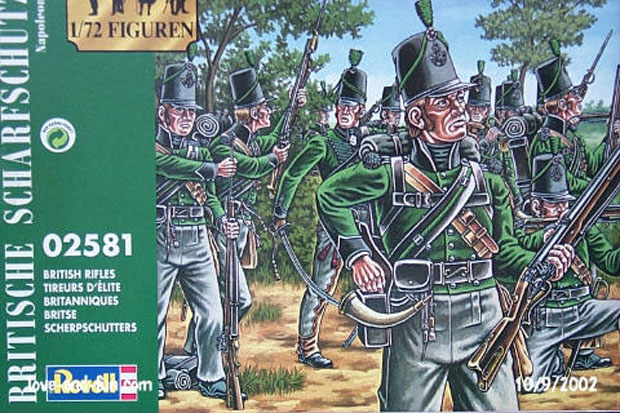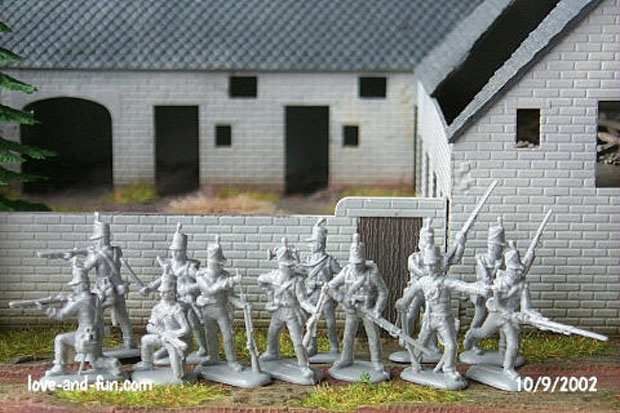British Napoleonic Rifles, 1808–1815
Revell 1:72 Scale Figure Review

British soldiers of the 95th Rifles, wearing rifle green uniforms with black facings, and white piping. Regulations trousers were rifle green as well, although grey trousers may have been worn in the field. Riflemen attached to the 60th (Royal American) Regiment were similarly uniformed, except that they had red facings, and deep blue (5/60th) or grey (7/60th) trousers. Armed with the Baker rifle, these troops were expert marksmen capable of hitting targets well beyond normal musketry range. The Rifles earned fame during the 1808–1814 Peninsular Campaigns, and they served with distinction at Waterloo in 1815.

The figure poses are perfect for wargamers who need firing, loading, and observing riflemen to deploy on their skirmish stands. Riflemen were trained to work in pairs. One man would fire and reload, while his buddy covered him.
Contents
42 miniatures in 12 Poses – 23 mm equal 166 cm Height
- Officer
- Bugler
- NCO advancing (2)
- Rifleman, standing, firing (5)
- Rifleman, kneeling, firing (4)
- Rifleman, loading, priming the pan (4)
- Rifleman, loading, handling cartridge (4)
- Rifleman, loading, ramming the charge (5)
- Rifleman, standing, fixed bayonet (4)
- Rifleman, running, fixed bayonet (4)
- Rifleman, charging, fixed bayonet (4)
- Rifleman, advancing, drawn bayonet (4)
Equipment
- Discarded knapsack (15)
Evaluation
Nicely detailed miniatures. Folds in the clothing, collars and facings, shako covers, rolled cloaks, canteens, gaiters, belts, buttons, pouches, sabres, muskets and metal fittings are well sculpted and easy to paint. The figures are noticeably shorter and slimmer than the Napoleonic miniatures from other manufacturers or even Revell’s own French Old Guard Grenadiers. The sculpting style is similar to Revell’s Prussian Napoleonic infantry.
Useful historic poses. The figures appear very natural, because of the standard poses which have been used. All of the 42 soldiers make excellent wargame and diorama figures, they may be deployed in firing, advancing, defending and marching units. Relatively few riflemen were engaged in the Napoleonic Wars, and wargamers will find all the figures they need in this set. In addition, the figures lend themselves to a number of interesting conversion.
Correct painting instructions on the box: The men are shown in the grey field service trousers, instead of the green trousers worn with full dress.
Satisfactory casting quality. There is some flash, and noticeable mould lines need to be removed prior to painting. Two poses carry mould lines down the center of the face which require careful attention.
The officer’s index finger is much too big compared to the other fingers on that hand. A little carving work will be required to fix that.
One of the advancing riflemen looks like he is about to engage in a sword-fight, using his bayonet. The pose would have been more attractive with the man actually fixing the bayonet on his rifle, because he is already holding the rifle in the required position. The bugler is holding his rifle in an uncomfortable position. The pose may be improved by bending and relaxing the arm a little.
The charging rifleman appears to be ambling, he has his left foot forward and the left arm extended forward at the same time. This pose is not nearly as good as the running poses in Revell’s Soviet infantry of World War Two.
Historical Employment
- 60th (Royal American) Regiment 1808–1815
- 5/60th Regiment, 3rd Infantry Division, Salamanca 1812
- 7/60th Regiment, Flank Companies, North America 1812–1815
- 95th Rifles 1808–1815
- 1/95th Rifles, 5th Allied Brigade, Picton’s Division, Waterloo 1815
- 2/95th Rifles, 3rd British Brigade, Clinton’s Division, Waterloo 1815
- 3/95th Rifles (2 coys), 3rd British Brigade, Clinton’s Division, Waterloo 1815
Possible Conversions
- King’s German Legion Light Infantry 1808–1815
- 1st Light Battalion, KGL. British rifle uniform with black shoulder-rolls, except that the officers did not have hussar style braid on their jackets.
- 2nd Light Battalion, KGL. British rifle uniform, black ball-pompom on shako.
- 28th (North Gloucestershire) Regiment 1808–1815.
Line infantry uniform, light infantry stovepipe shako without cords.
Some men may have carried French knapsacks originally captured in Egypt. - British Light Infantry 1808–1815.
Line infantry flank-company uniform with wings and fringes,
light infantry stovepipe shako without cords.- 51st (2nd Yorkshire West Riding) Light Infantry
- 52nd (Oxfordshire) Light Infantry
- 68th (Durham) Light Infantry
- 71st (Glasgow Highland) Light Infantry
- 85th (Bucks Volunteers) Light Infantry
- Hanoverian Light Infantry & Landwehr
- Lüneburg Light Battalion, 1814–1815
- Grubenhagen Light Battalion, 1814–1815. Light infantry shako without brim.
- Landwehr Infantry, 1814–1815. British line infantry uniform, light infantry stovepipe shako with cords arranged in British line infantry style. Officers wore regulation British line infantry uniform.
- Netherlands National Militia, 1814–1815. French line infantry style uniform, and British light infantry style stovepipe shako without cords.
- Prussian 21st (4th Pommeranian) Infanterie-Regiment 1813–1815
- 1st and 2nd Battalion wore Portuguese style infantry uniform with shoulder-rolls, and conical light infantry style shako without cords.
- 3rd Battalion wore British rifle uniform with shoulder-rolls.
Bibliography
- Haythornthwaite, Philip: Uniforms of Waterloo, plate 18
- Funcken, L. & F.: L’Uniforme et les Armes des Soldats du Premier Empire, p. 99
- Allevi, Piersergio: Zinnsoldaten, p. 13
British Rifles are a must-have for Napoleonic wargamers and modellers. These Revell figures are great, they fill the niche perfectly. Rifles are a rare troop type, and it is unlikely that gamers and collectors will need many boxes of them. Fortunately for Revell, a similar style of uniform was worn by other allied units engaged in the 1814–1815 campaigns.